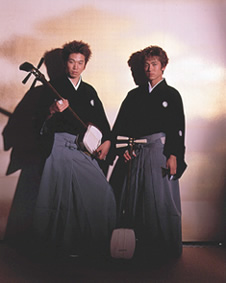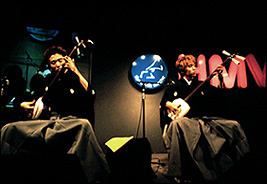 The Yoshida Brothers have dyed-brown hair that is representative of Japan's younger generation. But these two young men passionately perform music while wearing traditional Japanese hakama (trouser-like split skirts worn over the kimono). The music that they play has the power of rock music, and the dynamic tone that comes from their instruments is attracting many young fans in Japan. The Yoshida Brothers have dyed-brown hair that is representative of Japan's younger generation. But these two young men passionately perform music while wearing traditional Japanese hakama (trouser-like split skirts worn over the kimono). The music that they play has the power of rock music, and the dynamic tone that comes from their instruments is attracting many young fans in Japan.
The instruments that Ryoichiro Yoshida, 23, and his brother Ken'ichi, 21, are playing are called Tsugaru shamisen. It's a type of shamisen, a traditional three-stringed instrument, and it developed in the Tsugaru district of Aomori Prefecture. It's larger than other types of shamisen, is played aggressively, and is strummed rather than plucked.
While the Yoshida Brothers keep alive the traditional way of playing the Tsugaru shamisen, they also play their own original music, combining pop-like rhythms and slightly guitar-like playing. To the listener, it doesn't sound like traditional music; it sounds like something completely new. They released their first CD, Ibuki, in November 1999, and it has sold over 90,000 copies to date. In the world of shamisen music, albums typically sell about 5,000 copies per year, so Ibuki can be called an incredible hit.
 The Yoshida Brothers have other challenges in mind, too. They've had sessions with jazz musicians and have engaged in collaborations with musicians playing folk instruments from around the world. In November 2000 they released their second CD, Move. Of the eight tracks on the album, three involve the cajon (a box-shaped drum made of wood with a hole in the back), a traditional instrument of Peru. On another track, they perform together with an otsuzumi, a type of taiko (Japanese drum) that is laid sideways on the left knee and struck with the right hand. This album has also been popular and has already sold over 70,000 copies. Although it's not on their album, the brothers also have a piece that they perform with an instrument from Mongolia called the morin khuur (horse-head fiddle). As for further work, Ken'ichi says, "We're interested in collaborating with European instruments, particularly Spanish flamenco guitars."
The Yoshida Brothers have other challenges in mind, too. They've had sessions with jazz musicians and have engaged in collaborations with musicians playing folk instruments from around the world. In November 2000 they released their second CD, Move. Of the eight tracks on the album, three involve the cajon (a box-shaped drum made of wood with a hole in the back), a traditional instrument of Peru. On another track, they perform together with an otsuzumi, a type of taiko (Japanese drum) that is laid sideways on the left knee and struck with the right hand. This album has also been popular and has already sold over 70,000 copies. Although it's not on their album, the brothers also have a piece that they perform with an instrument from Mongolia called the morin khuur (horse-head fiddle). As for further work, Ken'ichi says, "We're interested in collaborating with European instruments, particularly Spanish flamenco guitars."
Beginning in spring 2002, Japanese instruments will become a part of the curriculum at all Japanese middle schools. Because of this, the Yoshida Brothers are increasingly being invited to perform at schools. Since they want young people to experience the Tsugaru shamisen up close, they give school recitals as often as possible. Many of the kids have never heard traditional Japanese instruments, but whenever the Yoshida Brothers go to a school, all of them listen intently.
Even though they are brothers, Ryoichiro and Ken'ichi have different styles of playing. Ryoichiro says, "When we play solo, we can express our individuality. When we play together, Ken'ichi plays in a powerful style, while I play lyrically." About his dream for the future, Ryoichiro says, "I want to arrange more and more folk music and show it to younger people." Many people can't wait to see what the Yoshida Brothers will do next.
Photos: (Top) The Yoshida Brothers in traditional outfit; (above) when the brothers perform, they look as if they're playing rock music! (©Japan Victor Foundation for Promotion of Traditional Music)
For more information about the Yoshida Brothers, you can e-mail the Japan Victor Foundation for Promotion of Traditional Music at fujiki@japo-net.or.jp.
You can also try visiting the Yoshida Brothers' official Website (Japanese only).
|
 The Yoshida Brothers have dyed-brown hair that is representative of Japan's younger generation. But these two young men passionately perform music while wearing traditional Japanese hakama (trouser-like split skirts worn over the kimono). The music that they play has the power of rock music, and the dynamic tone that comes from their instruments is attracting many young fans in Japan.
The Yoshida Brothers have dyed-brown hair that is representative of Japan's younger generation. But these two young men passionately perform music while wearing traditional Japanese hakama (trouser-like split skirts worn over the kimono). The music that they play has the power of rock music, and the dynamic tone that comes from their instruments is attracting many young fans in Japan.

 The Yoshida Brothers have other challenges in mind, too. They've had sessions with jazz musicians and have engaged in collaborations with musicians playing folk instruments from around the world. In November 2000 they released their second CD, Move. Of the eight tracks on the album, three involve the cajon (a box-shaped drum made of wood with a hole in the back), a traditional instrument of Peru. On another track, they perform together with an otsuzumi, a type of taiko (Japanese drum) that is laid sideways on the left knee and struck with the right hand. This album has also been popular and has already sold over 70,000 copies. Although it's not on their album, the brothers also have a piece that they perform with an instrument from Mongolia called the morin khuur (horse-head fiddle). As for further work, Ken'ichi says, "We're interested in collaborating with European instruments, particularly Spanish flamenco guitars."
The Yoshida Brothers have other challenges in mind, too. They've had sessions with jazz musicians and have engaged in collaborations with musicians playing folk instruments from around the world. In November 2000 they released their second CD, Move. Of the eight tracks on the album, three involve the cajon (a box-shaped drum made of wood with a hole in the back), a traditional instrument of Peru. On another track, they perform together with an otsuzumi, a type of taiko (Japanese drum) that is laid sideways on the left knee and struck with the right hand. This album has also been popular and has already sold over 70,000 copies. Although it's not on their album, the brothers also have a piece that they perform with an instrument from Mongolia called the morin khuur (horse-head fiddle). As for further work, Ken'ichi says, "We're interested in collaborating with European instruments, particularly Spanish flamenco guitars."